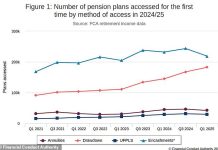I’m currently 32 weeks pregnant, and already thinking about childcare when I go back to work next year.
We have reserved a place for our baby in a nursery near where we live and I’ve seen that I can now get 30 hours of free childcare per week, up from 15 previously, which is great.
However, I’m confused about what is included and when we can use these hours.
Friends have told me horror stories about nurseries charging for lots of ‘extras’ on top of the already expensive fees, such as lunch or nappies. What does the funding cover and what do we pay extra for?
Also, my fiancé and I will both be working full-time after my maternity leave, but I’ve seen these free hours are only available during term times. How does that work? S.D

From this month, 30 hours of free childcare per week is now available in England
Harvey Dorset, of This is Money, replies: The first couple of years of being a parent can be an incredibly stressful period, where you will find yourself grappling with all manner of problems you have never had to confront previously.
The good news is that you have already organised a nursery place for your child. Some areas have nursery waiting lists that stretch well over a year, so it is important to plan this ahead of time.
As discussed below, the new 30 hours of free childcare will be available once your child reaches nine moths old, after which point you can access 30 hours per week free of charge during term time.
To find out exactly what you need to know in order to make the most of this free-care allowance, This is Money spoke to financial adviser Natasha Percy-Baxter and Family Action expert Karen Woodcock.
Natasha Percy-Baxter, principal at St. James’s Place partner practice, PercyBaxter Wealth Management, replies: First of all, congratulations on your exciting news. It is great that you are exploring your options now.
From this month, 30 hours of free childcare per week is available to children from ages nine months to four years in England. Previously it was only available for children aged three to four.
According to some estimates this could save parents £7,500 per child, per year in childcare fees.
This entitlement begins the term after your child turns nine months old. So, if your child was to turn nine months in August, the next term would be September. For clarity, the two other terms are January and April.
To be eligible, both parents must be in paid work, or about to start, with each of their salaries between 16 hours per week at the national minimum wage (roughly £2,539 over three months) and £100,000 per year.
Single parents can apply if they meet the same criteria.

Extra charge: Things like nappies aren’t usually included in the free childcare hours
You can apply for your 30 funded hours via the gov.uk website. Don’t forget that you will need to re-confirm your eligibility every three months via your childcare account to keep your place active.
It is worth popping a reminder in your calendar so you don’t forget, which could be easily done when you are sleep deprived and lacking a routine.
The funding will pay for up to 30 hours per week over term time, equivalent to 1,140 hours per year per child of childcare based on 38 weeks of term time.
The nursery may charge you for extras. These could include meals and snacks, consumables (nappies, wipes, sun cream), optional activities (outings, classes such as music, language or cooking) and additional hours.
The key thing to be aware of is that these extras must be voluntary and not a precondition for accessing the free hours. A nursery cannot impose on you top-up fees, registration fees or deposits.
I would also recommend asking the nursery if you can provide the extras they might charge for yourself, such as nappies or snacks.
Can they spread the hours over the whole year?
Karen Woodcock, early years manager at charity Family Action, replies: It’s wonderful that you’re already thinking ahead about childcare, especially with your baby on the way.
This support is designed to help families balance work and home life and make quality childcare more accessible.
You can check your eligibility and apply through the government’s website. It’s a good idea to apply in advance so everything is in place when you need it.
The funding covers up to 30 hours of childcare per week, during term time (38 weeks a year).
It’s a fantastic help with the cost of nursery care, but it’s important to know that nurseries may charge for anything beyond those funded hours.
Most nurseries are happy to explain their fees and help you plan around them.
While the standard offer is 30 hours per week for 38 weeks, which adds up to 1,140 hours per year, many nurseries offer a ‘stretched’ option.
This means they spread the hours across the whole year, which can be really helpful if you need childcare during school holidays or year-round.
If you choose this option, your weekly funded hours will be lower.
For example, if you split your 1,140 hours across the whole 52 weeks of the year, you would get 22 hours per week over 52 weeks.
You’ll then pay for any extra hours your child attends. Your nursery can help you work out what this looks like and what the costs might be.
SAVE MONEY, MAKE MONEY

Sipp cashback

Sipp cashback
£200 when you deposit or transfer £15,000
4.38% cash Isa
4.38% cash Isa
Trading 212: 0.53% fixed 12-month bonus

£20 off motoring

£20 off motoring
This is Money Motoring Club voucher

Up to £100 free share

Up to £100 free share
Get a free share worth £10 to £100

No fees on 30 funds

No fees on 30 funds
Potentially zero-fee investing in an Isa or Sipp
Affiliate links: If you take out a product This is Money may earn a commission. These deals are chosen by our editorial team, as we think they are worth highlighting. This does not affect our editorial independence. Terms and conditions apply on all offers.
#weeks #pregnant #free #childcare #hours #work
















